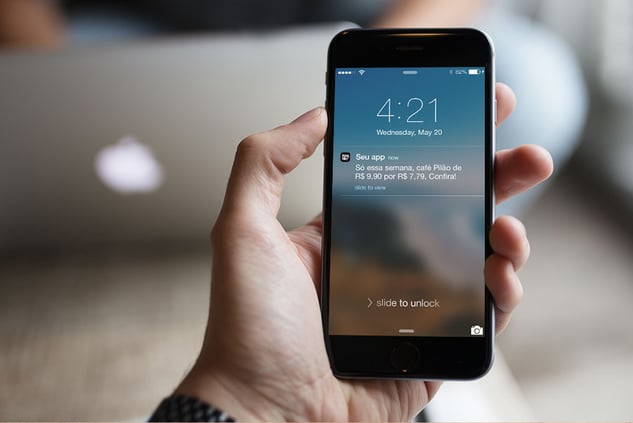Index Content
While apps continue to dominate the mobile market, many marketers are looking for creative alternatives that can be applied in this context. There are different strategies they can take, but push notifications are the most effective.
More complex than text messaging, push is a modern form of communication, and it is one of the mobile strategies that can increase my company's ROI.
Like texts, push messages are delivered directly to users' phones when they have installed an app, but unlike traditional messaging, they have a wide range of personalisation options that can increase user engagement and interaction.
what are push notifications?
Push notifications are those messages that we receive on our devices (mobiles, tablets, computers) from the applications we have installed. They are completely immediate, so it is not necessary for the user to continuously update the information to receive news.
An example to understand what push notifications are is WhatsApp messages, which automatically turn on the screen of our mobile phone every time we receive a new message.
Nowadays, practically all applications have already installed this technology linked to their subscribers. It is worth knowing that the first to install push notifications was BlackBerry, allowing emails to appear without the user having to open the application.
It is clear what push notifications are, but be careful not to confuse them with text messages. Texting and push notifications are so similar that they are sometimes talked about as if they were one and the same thing. However, despite having similar characteristics, there are marked differences. It is important to clarify the difference between these two types of actions.

Advantages of push messages
You already know what push notifications are, but if you have not yet decided on this strategy, here are the main advantages:
- The cost of notifications
push notifications are completely unlimited and free messages, this is one of the main advantages compared to text messages. Many users do not have unlimited text messaging rates and will be charged for the messages you send. This can anger users and create a bad brand image.
- Opt-in / opt-out
The opt-in/opt-out dynamic also favours push notifications, when it comes to user attitude. People have full control over which apps send them notifications and can even specify what types of notifications they want from each app.
- Improves engagement
Push notifications also increase engagement and improve user retention rates as they are less intrusive than conventional messages.
Push notifications serve a dual function because, in addition to offering a number of benefits such as promotions or offers, the brand is able to improve its engagement, which translates into an increase in ROI.
- Personalise your push notifications
Push notifications have the ability to be personalised. For example, you can send a push notification message easily designed in seconds and offering users a 10% discount on an action you propose. This not only helps to attract new customers but can also help to increase the loyalty rate of your customers.
Tips for using push notifications
The use you want to make of push notifications is very broad and will depend on your objectives and the personal needs of both the consumer and the business needs of your business.
Some examples of uses that applications give to this type of notifications are: to warn of new messages (especially in instant communication or email Apps), to alert of breaking news (frequent in digital newspapers) or even to inform of the weather or traffic in the city where the user lives (very typical of Google).
Here are some tips on how to use this CTA tool:
- Don't be overly insistent
Use the benefits of push notifications but don't be insistent. Use a language that is not too advertising, this will please users as they won't feel pressured.
Don't forget that it is a message that is sent to the consumer and they have a limited amount of characters to write. Make the most of them. Work on the content marketing strategies that you are probably considering for other types of actions.
- Distinguish your buyer persona
It doesn't make sense to send the same message to all your users, so you should personalise your message according to the user. The tools through which push notifications are sent have the possibility of creating virtual limits. If a user enters these limits, a notification is sent to them after a certain period of time.
This greatly reduces the likelihood that you will invade users with offers they are not interested in.
One option is to use an email marketing campaign to deliver a specific piece of news that might be of interest to everyone, but push notifications should only reach users who are likely to take advantage of what you are offering.
- Be aware of days and times
Poorly planned push notifications can turn people away, so it's important to consider the lifestyle and habits of your users.
For example, it is best to avoid Mondays, as users are considered to be slightly busier at the start of the week than on other days, and Tuesdays to Fridays they are more receptive to receiving information from brands.
This does not apply to all your users either - it is better to analyse who and how your potential customers are, so that you have a better chance of achieving absolute success with your push notifications.
The main starting point is to send messages when users have enough downtime to read them, but without interrupting their off hours.
Your position as a brand is privileged as users have actively wanted to subscribe to your website or download your app to receive news and stay up to date with your business.
However, don't overdo it and bombard them with your messages - don't make them change their minds.
This type of strategy can be a great ally for your brand, but the downside is that if you don't do your job properly, users can easily interpret push notifications as something negative.
As you have seen, push notifications are very trendy. The advantages they offer at a business level are endless if you know how to manage them in the most appropriate way with respect to your marketing objectives. Push messages not only have informative advantages for your users, but also create a better brand-customer relationship, which will be reflected in the overall growth of your business.





